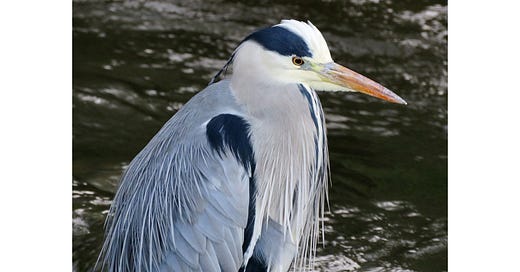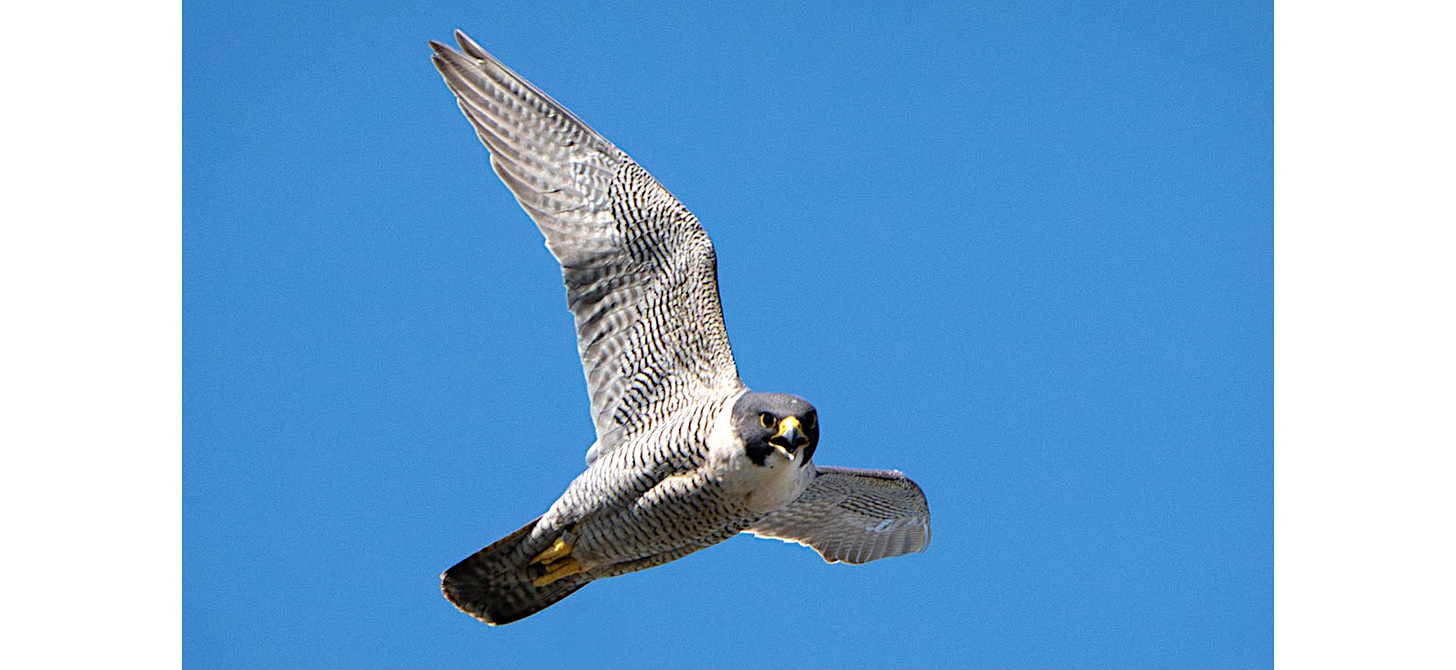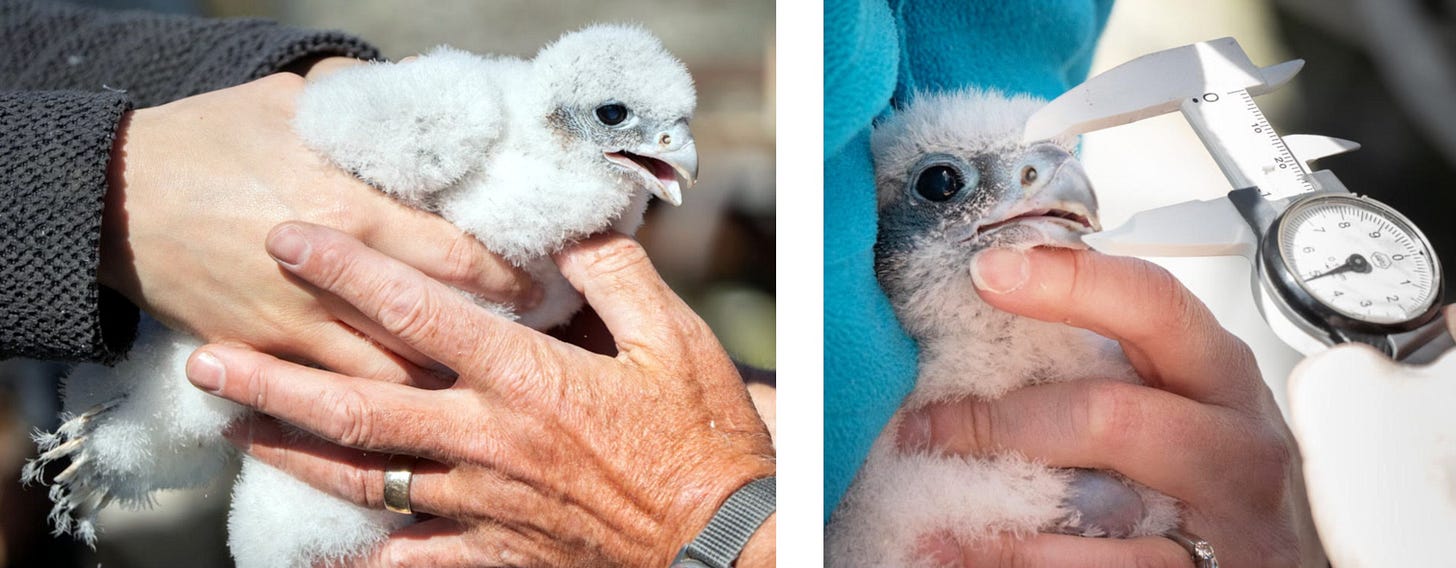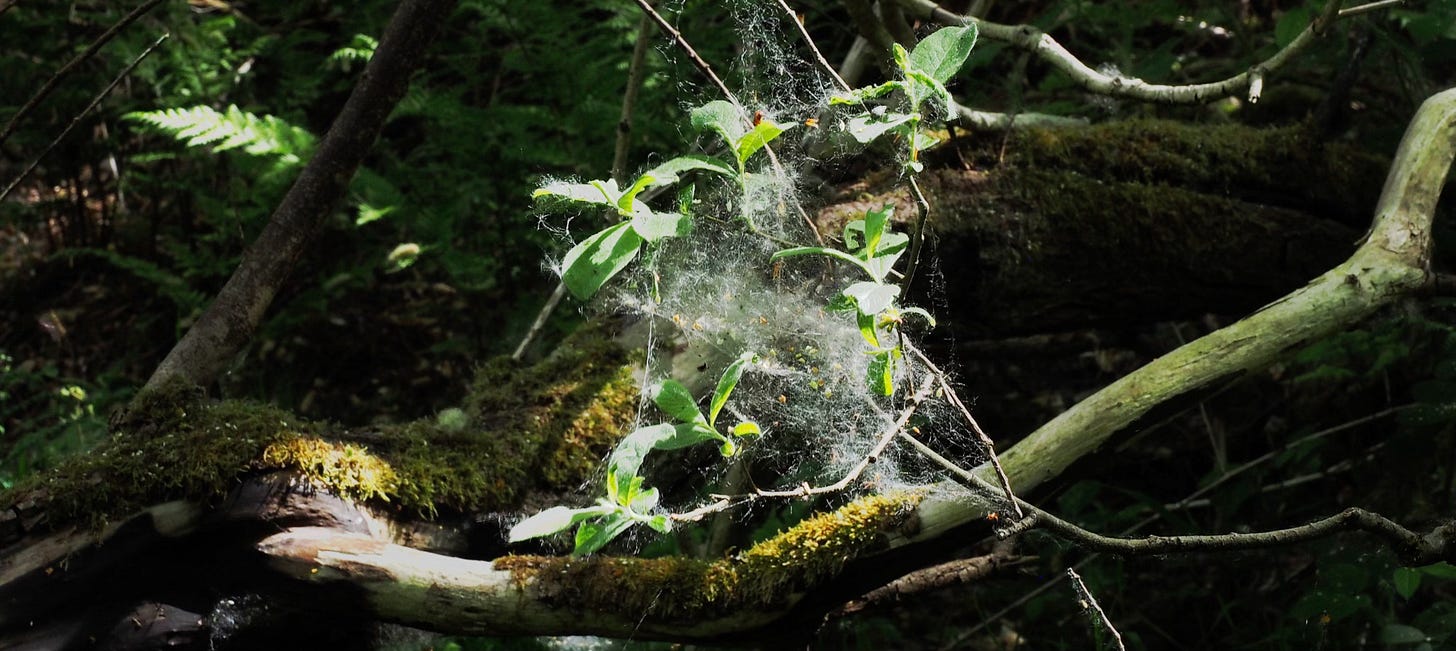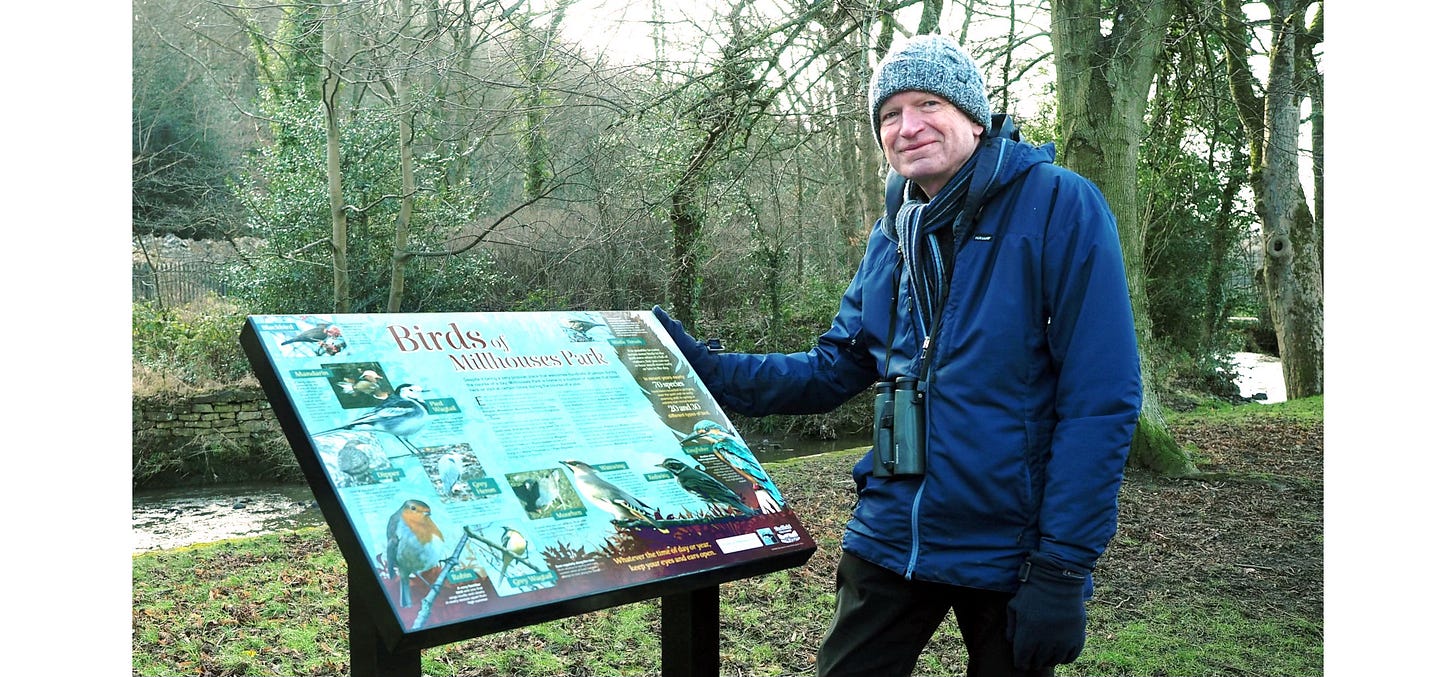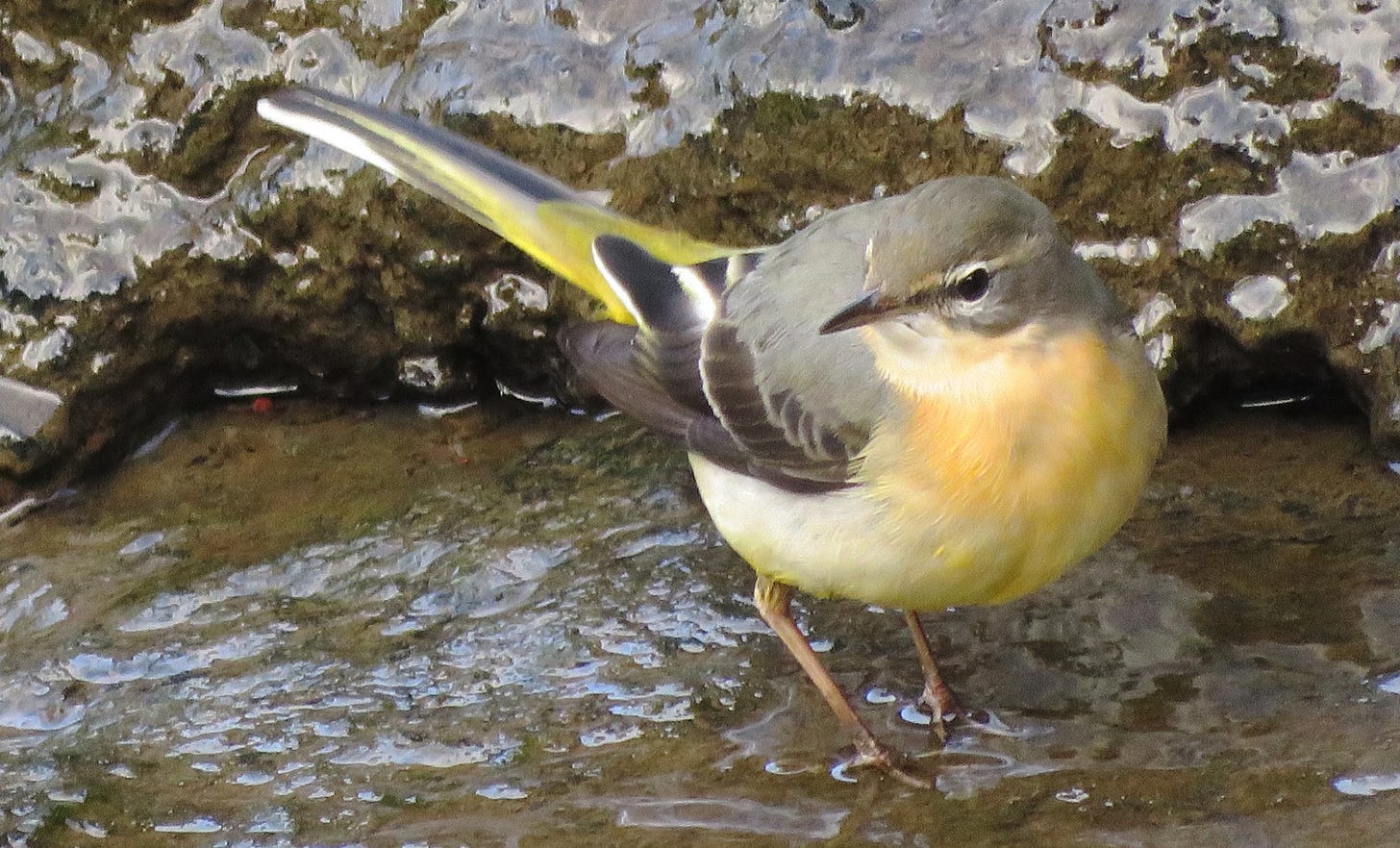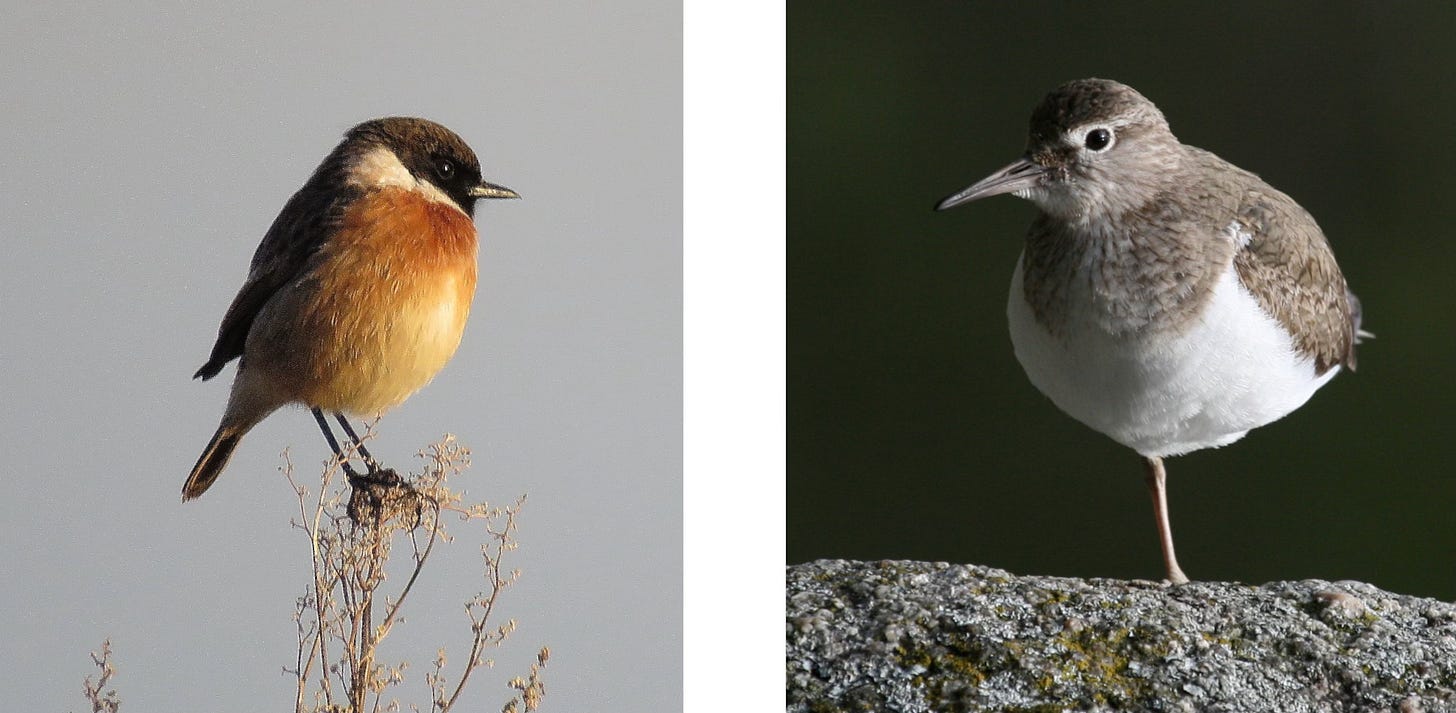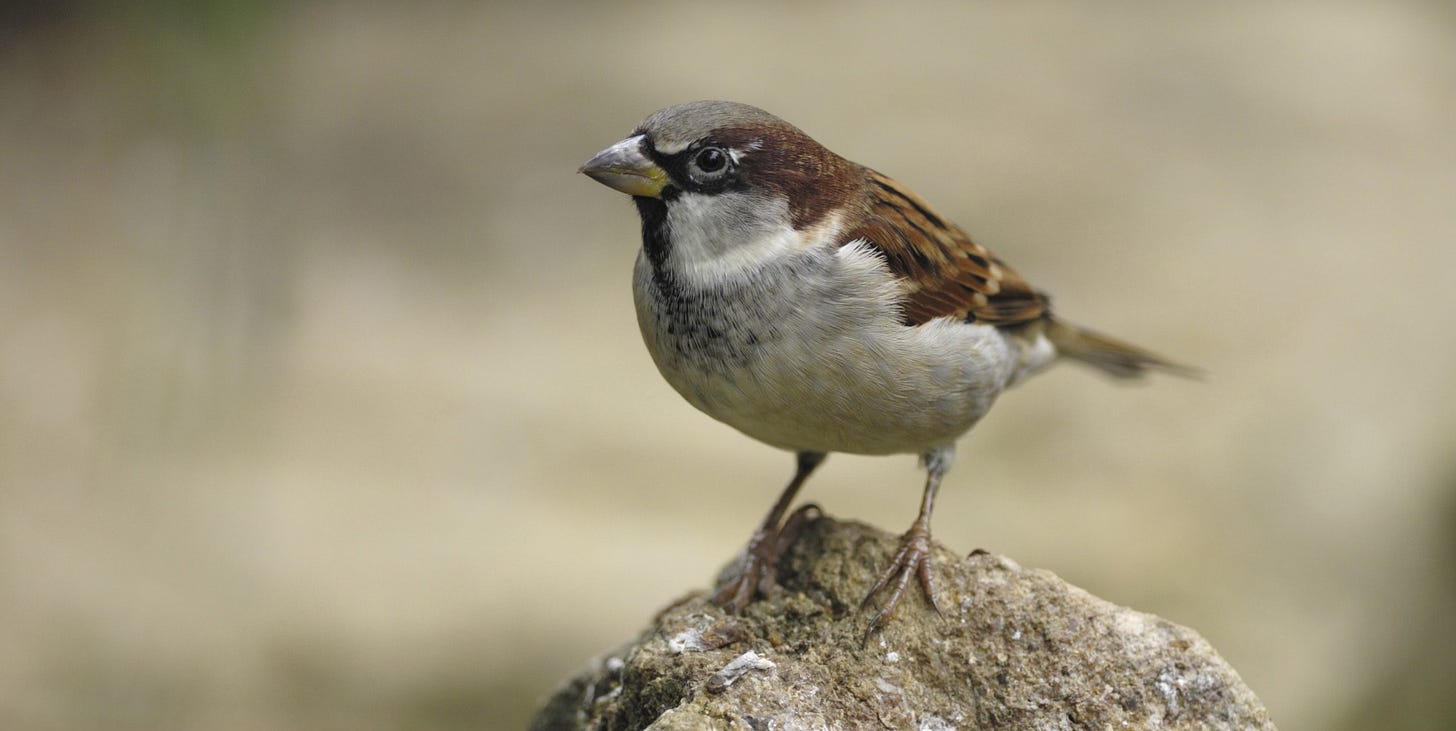Sunday at Bill's Mother's: 1st June 2025
Stonechats, Sandpipers, Stock Doves and Skylarks (and dozens more singing Sheffield birds) on a free bus pass. Also, falcon fledglings, and wild woods.
Morning. A flying issue today, with an astounding array of winged Sheffielders found in a single day of free city travel, with some strange soap opera news from the St George’s clocktower, where the city’s young Peregrine Falcons are about to launch themselves into the world. And a taster of our next wild woodland feature, which I hope to post in our first midweek edition in a few days.
We’ve had lots of congratulations about reaching our sustainability target of 305 full paying supporters. But sadly there’s always churn in Substack, where people leave the city, change their jobs, or take an interest in something else instead. Our targets are frustratingly moving, but generating enough income from readers is the only way to pay the bills and make this publication happen.
So if you like what you read, and like what we’re trying to do in this social enterprise of 305 (ish) members, please take out a full subscription so we can keep going and growing. At 380 full supporters, we’ll be so sustainable we can offer employment to freelancers to join us out in the field (and moors, and woods). Thanks.
Leap of Faith
Keep your eyes on St George’s church tower this week (or at least the webcam covering the residents) as our baby Peregrine Falcon chicks are about to launch into the skies above Broad Street roundabout.
Chris Greenwood from Sheffield Bird Study Group (SBSG) clambered out to the breeding platform two weeks ago with a team from Sorby Breck Ringing Group.
The chicks are weighed and measured, with data like foot span and toe length recorded. This is easier than it sounds, says Chris, as a Peregrine Falcon’s talons are big enough to measure after a little over two weeks: they develop feet first so they can hold on tight to their sky high platform as they get ready to leave.
Ringing is an important part of measuring the welfare of the Sheffield Peregrines, who began breeding high above the University in 2012. (The webcam and blog are a collaboration between supportive Sheffield University staff and SBSG).
Sightings of ringed falcons show one Sheffield bird made a new home at Wakefield, with Sheffield Peregrine grandchildren finding their way to Durham. Somewhat disturbingly, the ringing programme also revealed that a successful challenger for the wing of the resident Sheffield female turned out to be the female falcon’s own son, who saw off her previous consort a few years ago. Mother and mating son have now produced three broods together.
Chris warns against human squeamishness: this is uncommon but does happen among Peregrines and other birds, and in this case seems to have had little or no effect on the survival of the chicks. In fact, the current mother and son pair are doing better than the previous male, who seemed only to produce male chicks.
Peregrine Falcons were rare in the UK a few decades ago, but many have now adapted to city life, where church towers resemble the gnarled sea cliffs where the birds were in decline, possibility due to persecution from humans and other predators.
Most major cities now have a Peregrine Falcon family, Chris says, and citizens far below get used to seeing dismembered half starlings, pigeons or garden birds dropped by feeding falcons. One of the Sheffield pair recently brought home a Swift. “At 45-50mph that’s arguably our fastest bird in level flight, so to catch a Swift is remarkable,” says Chris.
The Sheffield pair usually see off rival Peregrines, and in the UK there’s usually a few miles between each nest. (Here there might be a pair near the end of Sheffield Parkway, and another on the other side of Rotherham, I understand).
In cities like New York and Chicago, however, there are so many prey birds and tall buildings that nests might only be a few hundred metres apart, says Chris.
Ringing also shows the sad plight of young birds found dead on local streets or rooftops. Peregrines have to learn to fly and hunt quickly, before their first winter, and they can really only do this by trial and error, says Chris, as you can only see so much of your 200mph swooping parents from a ledge on St George’s church tower.
We should be able to watch the three young Peregrines take their maiden flight any day now. You see them hanging onto the edge working out when to go, says Chris.
“The brutal reality is it’s a leap of faith. For them, when they’ve never flown before, it’s a step into the next world.”
Wild Wood
After months of fly-tipped rubbish, the woodland of Redcar Brook is showing its true colours: dappled green and fluffy white.
Sheffield Council ecologist Ziggy Senkans joined me to explore the hidden brook below a path off Sheephill Road near Ringinglow. I’ll have more on our visit in our new midweek post, but for now have a look at the tangled wood and moss and mist of willow seeds.
This is wonderful, said Ziggy, and is this habitat so far from the lost temperate rain forests of Britain, which are supposed to lie west of the Pennines according to recent books and campaigning websites?
Moss doesn’t read the guidebooks, we observed, as Wrens and Willow Warblers sang in the shadows, the plastic bags and cannabis waste long forgotten.
Free Birding
Pete Brown has been a bird watcher for as long as he can remember. He began as a boy in Northumberland, and carried on for the last 55 years around Sheffield where he worked as a schoolteacher.
A member and former chairman of Sheffield Bird Study Group, and a regular contributor to local and national bird surveys, he might be called a ‘serious’ birder. But he’s also an affable, enthusiastic and easy going teacher, writer and sharer of birding knowledge.
Free birding, he explains, is when you forego the costs of car travel and use your own two feet for your birding explorations, along with an elderperson’s bus pass. Here’s Pete’s account of this year’s Free Birding Big Day, written for us to show the range of species out there if you care to listen and look, with or without a bus pass.
I bird watch because birding is fun. Once a year myself and two or three like-minded friends have set aside a day to take that fun to extremes. Since 1982, we’ve challenged ourselves to find as many bird species as possible during the course of one ‘big day’ in May, the optimum month for big birdwatching.
For the first 20 years we’d try and cover as many locations as possible, driving considerable distances in the process. But we now take a more enlightened approach, chasing our targets using only long walks and public transport. Our first local ‘free birding’ walk 20 years ago went from Millhouses Park to Rother Valley Country Park. (We were younger then, walking 22 miles and after 14 hours found 93 species.)
This year, Pete found 79 species after 15 miles of walking, five bus journeys and one tram ride. All being well, I’ll have a postscript with his conclusions in an expanded post later this week.
Sheffield Area Free Birding - May 6th 2025
It’s 4.30 a.m. and still dark, with a significant ground frost. None of that bothers early dawn chorus participants.
As I walk into Millhouses Park, I hear Robins and Blackbirds as the first principal songsters, with Wren, Blue Tit and Great Tit soon joining in.
The dawn chorus in spring is rather special. The air is clearer at this time, and there’s little human activity and associated noise. As I listen, Mistle Thrush, Song Thrush, Woodpigeon and Goldcrest join the mix. They’re all announcing their presence: the essence of the dawn chorus is birds singing loudly to restate their territorial claim, and to tell would-be interlopers that they’ve survived the night. So keep out!
By 4.45 there’s sufficient light to see my first birds: five pairs of Mandarin along a kilometre stretch of the Sheaf, a single drake Mallard and a Moorhen also on the river. A Grey Heron stands motionless detecting fish in the half light, and a pair of Goldfinches and a single Carrion Crow fly over.
Just after 5 a.m. and I’m at Tyzack’s Dam, at present in a sorry state with virtually no water as it awaits remedial work to restore this locally important wetland. Usually I’d be adding several more species here, but today a single Grey Wagtail is the closest I get to an aquatic species. In the trees surrounding the dam are singing Coal Tit, Chiffchaff and Blackcap.
At 5.10 I’m starting a gentle uphill stroll through Ecclesall Woods and via Whirlow and the Limb Valley to Ringinglow. The challenge is identifying new songsters with the dawn chorus regulars still in full voice. Nuthatch, Chaffinch, Stock Dove and Dunnock join the list and Tawny Owl and Pheasant make their own distinctive contributions.
Tufted Duck is a slightly unexpected sighting on Whirlow Dam, then temporarily birds are forgotten, as a bustle in the nearby undergrowth reveals a fox in close pursuit of a vocally terrified rabbit.
A little later in the Limb Brook Valley I come across a pair of Roe Deer and further along another Roe buck. The early morning is just as good for encountering mammals as it is for birds.
The upper Limb Brook valley produces a rush of new birds. The first of the day’s many Willow Warblers are in full song, a pair of Bullfinches and singing Garden Warbler keep the tally going and Magpie is upstaged by a fly over from a ‘cronking’ Raven. And then one of the day’s highlights, two singing Pied Flycatchers, special because I’ve never seen them before in over forty years of walking here. A notable record.
By 6.30 I’m walking the open roads from Ringinglow to Redmires Reservoirs. It’s getting sunny and warm, and I begin to meet my first humans of the day, cyclists, exchanging cheerful greetings on each encounter. And still plenty of new birds, though mostly fly overs. In the space of 45 minutes of walking I add Jay, Greenfinch, Swallow and Jackdaw, and then some upland species, Curlew, Pied Wagtail, Lapwing, Skylark, Meadow Pipit and Linnet,
At 7.30 I’ve reached Redmires and the next hour is productive. I quickly find Canada Goose, Greylag Goose, Oystercatcher and Lesser Black-backed Gull on the southern perimeter footpath. A distant Cuckoo calling is one of only two I hear during the day, but Reed Bunting and Whitethroat are present in good numbers. Two or three Sedge Warblers sing from the scrub, at least four Common Sandpipers call from the reservoir shorelines, and a single passage Wheatear is a welcome addition.
8.15 to 10.45 is about the moors and moorland fringe, walking up to Stanage Pole, along Stanage Edge and down into the Burbage Valley. I’m after the upland specialists now, and it’s going to take time to stop, scan and listen.
A singing Stonechat, the first of quite a few, is an expected sighting. Pairs of Red Grouse are detectable at some distance, and a hunting Short-eared Owl is an early candidate for bird of the day. A Redstart sings from a tree below Stanage Edge, the mournful call of a Golden Plover comes from Ringinglow Bog and much closer are the ‘chipping’ notes of a Snipe. A foraging male Ring Ouzel completes the upland set.
I pay only a brief visit to Longshaw, as I’ve already found most of the birds I’d expect to see there, though a Great Spotted Woodpecker is a bonus.
Now for a change of location and habitats, so I take my first bus journeys of the day, from Fox House to Sheffield Interchange and then out to Woodhouse Mill, adding only Feral Pigeon in the city centre to the list.
I’m at Orgreave Lakes by 12.20 and the count begins to grow rapidly. Starling and Buzzard are the first non-wetland species as a Cetti’s Warbler sings loudly but unseen by the banks of the Rother.
On the two lakes at Orgreave, most of the expected birds show in quick succession: Mute Swan, Coot, Cormorant, Great Crested Grebe, Black-headed Gull and Herring Gull. Then Little Egret, Gadwall, Pochard and Little Ringed Plover take a bit of finding, but I’m surprised by a total lack of Hirundines (Swallows and Martins) and Swifts over the lakes.
So I persevere. The new reeds at the northern end of the main lake hold at least four singing Reed Warblers and as I listen a party of about 20 House Martins appear over the water. Even better, a superb male Yellow Wagtail graces the northern shore.
It’s now 14.00. It’s warm and I’m getting tired. Time to begin the journey back to Sheffield with a look at Treeton Dyke en-route. I’m slightly delayed by a conversation among 30 camera-toting railway enthusiasts occupying a bridge along my route.
They’re waiting to see the ‘Flying Scotsman’ on its southward journey, but as it’s being towed and not under steam I fight the temptation to linger, and listen instead to a Lesser Whitethroat singing some distance away.
For my final search I decide to take a bus back into town then a tram along West Street to the former St George’s church to look for the resident Peregrines, as a fitting finale. Alas, the female is on the nest but out of sight, and the male is nowhere to be seen. And so two more bus rides home to enjoy a slightly different finale: House Sparrow, 15 of them in my back garden.
More What’s On Out There (from Sunday 1st June)
A tiny selection from our new (and regularly updated) What’s On Out There news and listings post for May and beyond.
Sun 1st - Sheffield Climate Choir (& others) ‘Sing for Clean Water’ at Millhouses Park
Mon 2nd - SRWT Volunteering - Crabtree Ponds
Tues 3rd - Friends of Ecclesall Woods volunteer & footpath repair session
Weds 4th - RSPB local group walk - Greno Woods
Sat 7th - Friends of Loxley Cemetery Open Day including ecological tour
Sat 7th - Friends of Whirlow Brook Park volunteer session
Next Sunday we hope to have a feature on how women are built for ultra running, thanks to new contributor (and one of my former editors!) Ellen Beardmore. And I hope to have our first midweek edition on Wednesday, with an astonishing visit to a tiny wet woodland cleared of fly tipped rubbish and full of life, along with more thoughts from Pete Brown, and our beginner birder learning about nestlings.
It’s Looking A Bit Black Over Bill’s Mother’s runs on free subscribers who reckon up that they can afford to upgrade and make this kind of local journalism happen. There’s no catch, just the cost of a Millhouses flat white a month.

